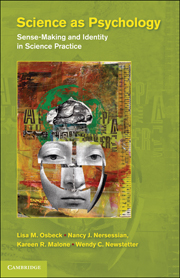Book contents
- Frontmatter
- Contents
- Acknowledgments
- 1 Introduction: Science and Persons
- 2 Methods of Study
- 3 The Problem-Solving Person
- 4 The Feeling Person
- 5 The Positioning Person
- 6 The Person Negotiating Cultural Identities
- 7 The Learning Person
- 8 Epilogue: Science as Psychology: A Tacit Tradition and Its Implications
- References
- Index
1 - Introduction: Science and Persons
Published online by Cambridge University Press: 05 July 2011
- Frontmatter
- Contents
- Acknowledgments
- 1 Introduction: Science and Persons
- 2 Methods of Study
- 3 The Problem-Solving Person
- 4 The Feeling Person
- 5 The Positioning Person
- 6 The Person Negotiating Cultural Identities
- 7 The Learning Person
- 8 Epilogue: Science as Psychology: A Tacit Tradition and Its Implications
- References
- Index
Summary
George Kelly used “scientist” as a metaphor for “person” to emphasize that understanding science practice – how scientists think and what they do – enables us to understand human nature more profoundly. In turn, understanding human nature invites critical appraisal of our notions of science as an activity of persons:
Psychologists are likely to be very much in earnest about making their discipline into a science. (Unfortunately, not many are as concerned as they might be about making science into something.)…But what would happen if one were to envision all human endeavor in those same terms the psychologists have found so illuminating in explaining themselves to their students? And indeed, might it not be that in doing so one would see the course of individual life, as well as human progress over the centuries, in clearer perspective? Scientists are men, and while it does not follow that men are scientists, it is quite appropriate to ask if it is not their human character that makes scientists what they are. This leads us to the question of how that human character can be better construed so as to account for scientists, and whether our construction can still explain as well the accomplishments that fall far short of what we, at this transient moment in our history, think good science is (George Kelly, unpublished manuscript quoted in Bannister & Mair, 1968, pp. 2–3).
- Type
- Chapter
- Information
- Science as PsychologySense-Making and Identity in Science Practice, pp. 1 - 30Publisher: Cambridge University PressPrint publication year: 2010



